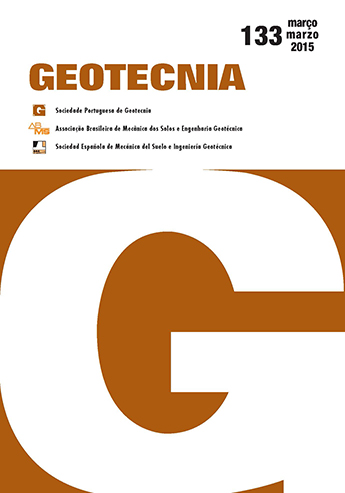In situ stress analysis of the Cuiaba Mine – Sabará – Minas Gerais - Brasil
DOI:
https://doi.org/10.24849/j.geot.2015.133.05Keywords:
In situ stress, Discing, BreakoutAbstract
In underground mine projects, the in situ stress knowledge is essential, since those need, directly or as an input, the stress orientation and magnitude for the underground excavations design, their support and reinforcement, construction numerical modeling, mining method and mining sequence selection, rockburst prediction and others. The in situ stress knowledge is generally based on in situ strain measurements, as the overcoring technique. Since they have a high cost, generally this kind of measurements is limited to some. Nevertheless, different information can be used for stress estimation known as indirect and indicative techniques, like discing and breakout. The analysis and comparison of the direct measurements with discing and breakout information provided to the Cuiaba Mine considerable data for its in situ stress model construction.
Downloads
References
Bewick, R.P.; Kaiser, P.K. (2009). Influence of rock mass anisotropy on tunnel stability. ROCKENG09: Proceedings of the 3rd CANUS Rock Mechanics Symposium. Toronto.
Heidbach, O.; Tingay, M.; Barth, A.; Reinecker, J.; Kurfeb, D.; Muller, B. (2008). The 2008 release of the World Stress Map. Disponível em: <http://www.world-stress-map.org>. Acesso em: Out. 2012.
Hudson, J.A.; Cooling, C.M. (1988). In situ rock stress and their measurements in the U.K. – Part I. The current state of knowledge. International Journal of Rock Mechanics Mining Sciences & Geomechanics Abstract, v. 25, n.6, pp. 363-370.
Hutchinson, D.J.; Diederichs, M.S. (1996). Cablebolting in underground mines. Vancouver: BiTech. 406p.
Lobato, L.M.; Ribeiro-Rodrigues, L.C.; Vieira, F.W.R. (2001). Brazil´s premier gold province. Part II: Geology and genesis of gold deposits in the Archean Rio das Velhas greenstone belt, Quadrilátero Ferrífero. Mineralium Deposita, v. 36, pp. 249-277.
Ribeiro-Rodrigues, L.C; Oliveira, C.G.; Friedrich, G. (2007). The Arquean BIF-hosted Cuiabá Gold deposit, Quadrilátero Ferrífero, Minas Gerais, Brazil. Ore Geology Reviews, v.32, pp. 543-570.
Stacey, T.R. (1982). Contribution to the mechanism of core discing. Journal of the South African Institute of Mining and Metallurgy, Johannesburg, v. 9, pp. 269-274.
Stephansson, O; Zang, A. (2012). ISRM Suggested Methods for Rock Stress Estimation – Part 5: Establishing a model for the in situ stress at a given site: Springer.
Disponível em: < http://link.springer.com/content/pdf/10.1007%2Fs00603-012-0270-x.pdf>. Acesso em: 13 ago.
Tropia, I.R. (2013). Análise das tensões in situ em ambiente de lavra subterrânea, Mina Cuiabá, Sabará, Minas Gerais. Dissertação (Mestrado em Mecânica das Rochas), Universidade Federal de Ouro Preto. Ouro Preto. 217p.
Zoback, M.D.; Moos, D.; Mastin, L.; Anderson, R. (1985). Wellbore breakouts and in situ stress. Journal of Geophysical Research, v. 90, n. B7, pp. 5523-5530.




